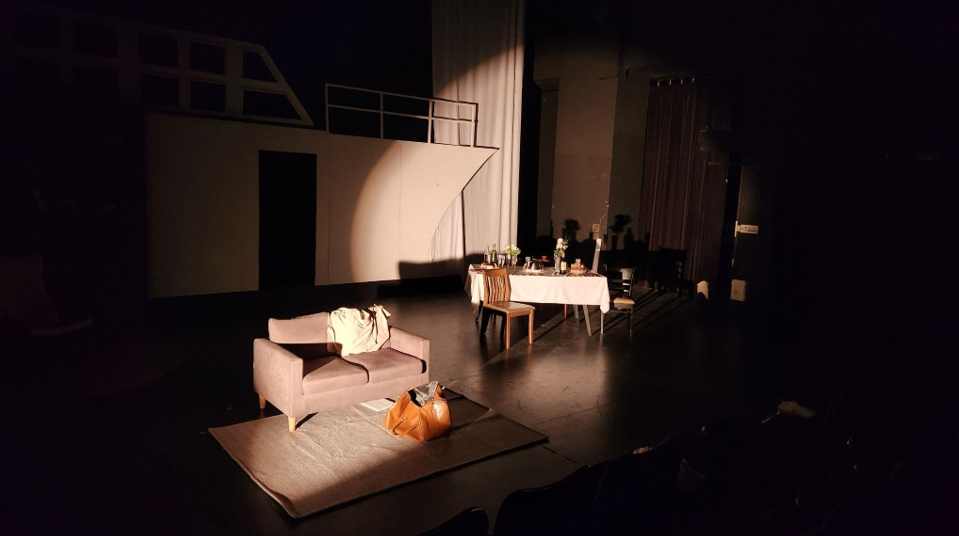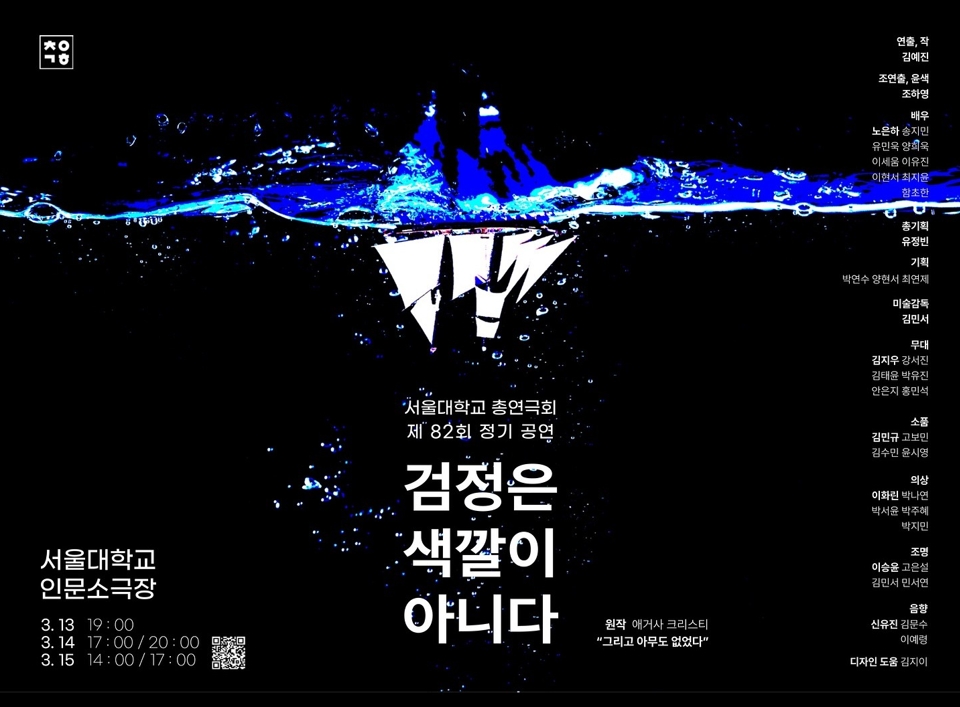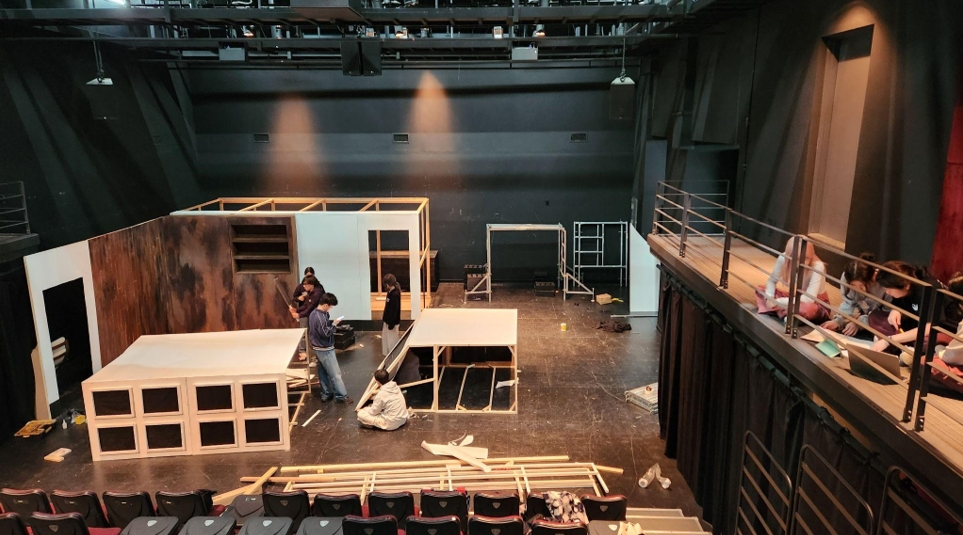“Ten little soldier boys … And then there were none.” (Christie)
Invited onto a luxury cruise ship by a mysterious person by the name White, nine people from vastly different backgrounds prepare to dine together when a voice accuses them all of murder. Overcome with fear, guilt, and suspicion, the characters become judge, jury, and executioner in a dangerous game of who can trust who. Some succumb to the accusations while others remain indifferent and unrepentant. None of this stops the bodies littering the stage, one by one, until there were none.
This is the synopsis of the SNU Drama Club (Chongyeongukke(총연극회))’s 82nd semesterly performance, titled Black is NOT a Color. The play took place at Theatrum Humanitatis in Building 14 from March 13 to 15 for a total of five separate showings. Based on Agatha Christie’s murder mystery novel And Then There Were None, the piece serves as a dramatic reimagining while preserving many of the original elements and storyline. Inspiration was also taken from the film Reservoir Dogs, as evident in the characters’ color-based names, which mirror the code names seen in the film.

The Performance Set of Black is NOT a Color
The key message of the play is that of the virtue of repentance and reflection on one’s own wrongdoings. The nature of each character’s crimes meant each murder could easily be written off as an accident and was nearly impossible to convict in court. Yet, despite this, each character suffered some form of agony as a result of their sins, forcing them out of their rationalizations of their crimes and into a period of reflection. “We all do wrong throughout our lives. What’s difficult is being able to acknowledge those wrongdoings and reflect on them,” Yoo Jeong-Bin, who was in charge of the general planning, said.
Color is a prominent motif throughout the play. The club made clever use of colored lighting to convey character emotions as well as hint towards the true mastermind behind the plan. “Black is NOT a Color. It’s the absence of color,” Pink, a character who was invited onto the boat for his crime of workplace negligence, says in a moment of foreshadowing.

Poster for the Performance Black is NOT a Color
Process of Creation: A Play in Working
The play was a testament to the blood, sweat, and tears the team poured into the rehearsal process. The actors showed off their passionate and convincing deliveries of their roles. The carefully selected music and sound effects maintained the suspenseful atmosphere, and the artful set and costume design left a striking impression.
Preparations for the performances began last year in October, starting with applications for the scriptwriting and director positions. Following this, the directors for each department—such as sound, lighting, and costume—were selected from a pool of experienced members in those fields. Auditions for actors and recruitment for production crew were held at the end of the fall semester and rehearsals began in early January. The actors practiced their lines and roles almost daily. These efforts culminated in the wonderful performance held early this March.
Yoo said the most difficult part of the preparation and rehearsal process was ensuring everything ran smoothly and resolving any conflicts that arose. This was particularly challenging as the team consisted of almost 40 people, each of whom inevitably had varying time commitments. However, the small yet precious moments such as finally seeing everyone in costume made every hardship along the way worth it.
Though the performances have now concluded, the SNU Drama Club still has many tasks to complete. The club conducts a review session after every semesterly performance to reflect on the efforts made in the past few months and gather feedback for the next performance.

Actors Rehearsing for the Play
SNU Drama Club: A Decades-Rich History
The SNU Drama Club was formally founded in 1986 and now holds its place as the sole central theater club at Seoul National University. With 77 years of history, the club’s beginnings can be traced back to 1947 with the performance of Anton Chekhov’s plays under the name of the National University Theater. “Our thoughts into our aesthetics” is the motto of the club, which strives to act as a point of liberation and breakthrough for suppressed theatrical passions.
A unique feature of the SNU Drama Club is that no position is fixed. The club aims to curate a space where members can freely choose to participate in performances, as well as choose what role they wish to play—be it acting, directing, or working as production staff. This way, members are able to experience a variety of jobs in the theater.

Setting Up the Stage
In addition to its semesterly performances, the SNU Drama Club hosts spring workshops for new members, giving them the opportunity to explore different theatrical departments and stage a short performance lasting between 5 to 10 minutes. In the fall, members are able to work alone or in groups of 2-3 to put on a monologue of approximately 10 minutes.
The SNU Drama Club is a great place for students with an interest in theater to meet like-minded individuals, or for those without prior interest, to cultivate a newfound passion for the art. As a welcoming space for anyone willing to come and explore theater, the club urges students to join and participate. Applications for the spring semester typically open in early April, and those interested are encouraged to look out for the upcoming notices.
Written by Eusun Lee, SNU English Editor, sunnylee006@snu.ac.kr
Works Cited: Christie, Agatha. And Then There Were None. 1939. Harpercollins Publishers, 2011.

